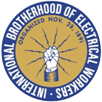Safety Regulations
Covid Guidelines
IBEW Local 349 follows Covid safety guidelines from both OSHA and Santa Clara County. All employers operating within the county should also be adhering to these same protocols. For more information go, to:
Santa Clara County Covid Guidelines: https://covid19.sccgov.org/home
Cal OSHA Covid Guidelines: https://www.dir.ca.gov/dosh/coronavirus/
OSHA Top 10 Safety Violations in 2021
IBEW Local 349 is proud of our record on safety. Our trained workforce prioritizes safety in everything we do, and our worksites have very few OSHA violations. To see how we compare with the rest of the construction industry – as well as general industry, manufacturing, and other fields – we went to OSHA’s top 10 most frequently cited violations webpage. The results are as follows. OSHA 29 CFR 1910 regulations detail general industry safety and apply to most worksites. Alternately, the OSHA 29 CFR 1926 standards focus on the construction industry.
#1: Fall Protection – General Requirements (1926.501): 5,295 violations
Many falls can be attributed to human error. Fall violations are common because dangerous and life-threatening falls have many causes. Here are just a few:
- Wet or muddy surfaces
- Uneven surfaces
- Inadequate lighting
- Improper ladder use
- Ladders with structural defects
- Cluttered work areas
- Inadequate guardrails
- Uncovered holes/shafts
- Dangerous weather conditions such as ice, snow, and wind
#2 Respiratory Protection (1910.134): 2,527 violations
The most common violation is the employer not providing a written medical evaluation prior to respirator use or fit testing, followed by lack of training and failing to identify hazardous conditions that require respirator use.
#3 Ladders (1926.1053): 2,026 violations
The most common ladder violations include: lack of worker training, improper use of the top of step ladders, and not having the ladder extend three feet above the landing.
#4 Scaffolding (1926.451): 1,948 violations
Scaffold violations include lack of fall protection while working 10 feet or more above a lower level. This includes a personal fall arrest system and/or guardrails. Anyone working on a scaffold must be trained by a qualified person to identify hazards and use the scaffold properly. Scaffolding must be erected and inspected by a qualified person.
#5 Hazard Communication (1910.1200): 1,947 violations
The most common violation is lack of safety data sheets (SDS) for hazardous materials. There should be a written program and training for hazardous chemical use.
#6 Lockout/Tagout (1910.147): 1,698 violations
This is a critical part of electrical safety anywhere that stored energy may be present. Common violations include:
- Failing to have equipment specific lockout/tagout procedures
- Lack of training
- Failing to conduct periodic inspections
- Failing to establish a lockout/tagout program
- Failing to follow the sequence of a procedure
- Failing to protect workers during group lockout/tagout operations
- Failing to identify all sources of energy or failing to lockout/tagout all sources
- Failing to notify other employers in multi-employer situations
#7 Fall Protection – Training Requirements (1926.503): 1,666 violations
The employer shall provide a training program for each employee who might be exposed to fall hazards. The program shall enable each employee to recognize the hazards of falling and shall train each employee in the procedures to be followed in order to minimize these hazards, including personal fall arrest systems, guardrails, warning lines, controlled access, and other protection.
#8 Personal Protective and Lifesaving Equipment – Eye and Face Protection (1926.102): 1,452 violations
Our typical personal protective equipment (PPE) includes eye protection with ansi z87.1 rating, hard hat, gloves, and high visibility safety vest with 2” reflective material. Depending on the task, there is a much longer list of PPE. Avoiding a violation is simple; wear your PPE while on the job site.
#9 Powered Industrial Trucks (1910.178): 1,420 violations
Operation of forklifts, “gradalls,” or other motorized material handling equipment is not always limited to material handlers. Anyone operating the equipment must be properly trained. Common failures include:
- Lift trucks driving off loading docks
- People struck by equipment or load
- People falling from elevated pallets
- Using incorrect attachments or making unapproved modifications
- Exceeding equipment load rating
- Failing to choose the correct equipment for the task
#10 Machine Guarding (1910.212): 1,113 violations
Machine guards must remain in place and not be altered. This rule generally applies to large machinery, but for our purposes, we will consider the guards on our tools.
For a more in-depth analysis of the Top 10 OSHA violations, go to:
https://www.osha.gov/laws-regs/regulations/standardnumber/1910 (general industry)
https://www.osha.gov/laws-regs/regulations/standardnumber/1926 (construction)

